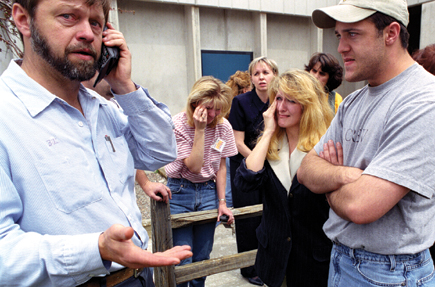On Assignment; The Photography Of Kevin Moloney Page 2
 |
|
|
Moloney remains a highly respected photographer for The New York Times and
I asked him how he dealt with the dark side of that work, such as the Columbine
shootings in Colorado.
"It was about the hardest thing I have ever had to photograph,"
he answered. "I arrived while the shootings were still taking place since
The New York Times had called me immediately. I was at my father's house
close by at the time and I grabbed his '72 F2 and all of his lenses as
well as 20 rolls of my mother's color film and made it over there in half
an hour.
"By the time I got there the police had put up their yellow tape so I
went to a nearby elementary school where the parents were sent to await news
of their children. I photographed the emotional reactions of these parents who
at the time didn't know if their children were alive or dead. It was a
hard time to be aiming my camera.
"One of the most interesting things I learned while doing that story was
how people react to the way a photographer does his work, how different it is
from the way they react to the work itself. There was a huge outpouring of sympathy
from the whole country and people came from everywhere to leave tokens to show
their sorrow. What brought them there was their response to the journalism,
the television, the radio, the newspapers, and it was an emotional one, yet
people were horrified by our numbers and it is interesting how they could react
so strongly to our work but not to how it is made."
 |
|
|
Moloney believes there are three kinds of photographers in photojournalism
and documentary, the first being "the readers' photographer,"
someone whose primary goal is to inform and please the reader, straight and
clear.
The second group is "the editor's photographer" who uses the
latest techniques and stays with the certain look that is popular in magazines
at the time. "That," he says, "makes good business sense because
we need to sell our images.
"The third," he says, "is the photographer's photographer,
one who makes complex and intriguing images like a lot of the Magnum photographers
do today or like those of Cartier-Bresson and Joseph Kudelka. These may baffle
the average person, though.
"Good photographers try to be all three," Moloney says. "When
you make images every day as your line of work, it is the straight, clear, and
simple ones that are most effective. They are not the ones that intrigue me,
however. It is those photographers who are more complex. They are the intriguing
ones who keep us doing our work the longest."
 |
|
|
Moloney refers to a favorite shot he made in India showing a big, electoral
campaign truck. In a circle that covered the speakers on the side of the truck
there is a picture of the candidate. A gazebo sitting within a little traffic
circle is evident in another part of the frame. A man with some bananas had
walked right into the frame and his head landed perfectly in the center of a
similar circle to the one containing the candidate. "For me it was a magical
moment where everything lined up exactly right. It's complex and visually
intriguing."
Moloney's most recent body of work, a feature for The New York Times,
is shot in Brazil, an in-depth series taken in Manaus, a bustling area where
fish are brought in and sold.
Internationally Moloney is known for his work in publications such as Stern,
Paris Match, and a variety of images have been published in Brazilian and other
German publications.
Moloney's commitment to his work deals with issues of humanity, illustrated
artfully in the situations he photographs and perhaps, most importantly, in
the insightful details that create the mood in his images.
To see more of Kevin Moloney's work, visit his website at: www.kevinmoloney.com.
- Log in or register to post comments

















































